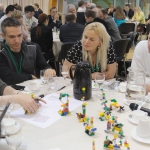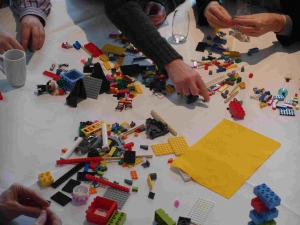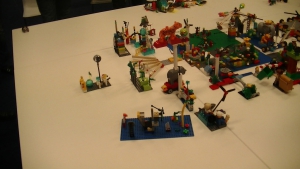Business Solutions with LEGO Serious Play
LEGO® Serious Play (LSP) is a facilitated method for strategic decision-making and problem resolution in business environments. The workshop results are always directly aligned to the business goals in focus and the results can be used the next day at the work floor immediately. The workshop participants are all equally involved in finding business solutions.
LEGO® Serious Play® helps to build participatory practices within organisations through visual and physical co-creation. It is a lean forward, hands on technique, where everyone plays and enables 100% participation and 100% buy-in.
Related to teir complexity are LEGO Serious Play (LSP) workshops aligned on different organisational levels:
- individual/team level, or
- department/organisational level, or
- a combination of both.
With LSP you can solve management and business issues like
- Defining a Shared Vision & Getting Commitment,
- Defining Business Strategy & Vision,
- Developing Business Process Management,
- Developing Teams & Employees,
- Implementing Culture Change, / Organ. Change,
- Performing Market Analysis, SWAT Analysis,
- Brainstorming Innovation & Ideation / Product Design,
- Defining Value Proposition & Value Added (Business Canvas),
- Aligning any topics to business goals in general.
LEGO® Serious Play is a facilitated method for strategic decision-making and problem resolution in business environments. All LEGO® Serious Play workshops results are directly aligned to the business goals in focus.
Roles involved
In a LSP workshop three roles are involved to assure the business alignment:
Groups or tables of max. 12 participants per facilitator are best to run a LSP workshop efficiently. Scale this if needed: 10 facilitators/10 tables, 20 facilitators/20 tables…, etc.
Why LEGO Serious Play Works
Thinking with the Hands
The workshop participants answer all questions by building LEGO® models. Participants construct the models in a flow of intense playing.
The models “emerge” out of the bricks at hand without any long-term rational pre-design.
By building the models with their hands the participants use their knowledge and imagination — much faster than traditional rational brainstorming techniques will do. They image and build their models instantaneously.
At this step very often a coarse story line of the story to be shared emerges unconsciously.
The Knowledge is already in the Room — Metaphors used in Stories
LSP unlocks the participant's hidden knowledge and constructs their new knowledge. Because LSP fosters the understanding of the system to be modelled, LSP sharpens the view for connecting purposes between organisation and individual unconsciously and with strong commitment. Playing with and challenging the model constructs new knowledge through self-reflection.
As metaphors the models opens a wide door of interpretation and fantasy. Metaphors provide richer descriptions of the reality, and open a wider look for new possibilities. They are used to give strong effect to a statement. Metaphors are used to give the reader/listener a better idea of the emotions/feelings of a situation.
In using metaphors you create a strong emotional impact in the reader's minds. LSP engages communication: participants explain the metaphors of all the model’s meanings.
Everybody Communicates Equally — Create Common Understanding
After finishing the models all participants explain why their model is an answer to the question raised. Everybody shares the story covering the meaning of the model: the thoughts, associations, emotions and feelings coming to mind when constructing.
All other participants get aware of personal reflections while listening.
Finally, all participants reflect key insights that are uncovered, ask clarification questions to the models, and sum up surprises and connections.
After each builder had told her story to the group
- The facilitator/participants ask further questions for more details.
- The builder provides the information wanted.
LSP workshops lead to a strong common commitment is created since by sharing each individual interpretation with all participants.
If it is beneficial to pinpoint the individual meanings, you can do this on personal as well as on group level:
- Personal Level: ask each participinat to write down for herself the answer to “What me most impressed on model X.”on a post-it.
- Group Level: ask the group to find homogeneous answer to “What me most impressed on model X.”
Paste the post-its beneath the models built.
Levels of Reflection and Abstraction
Depending on the complexity of the focussed business topics, the facilitator states questions on several levels of reflection and abstraction to solve the business issues and applies one or more of the following technique(s):
Further Readings
: Andrew Becraft, via flickr.com • Marko Rillo, via flickr.com • EOI Escuela de Organización Industrial, via flickr.com • Marko Rillo, via flickr.com • MTarnowski • webAtelier.net, via flickr.com, .


















Leave A Comment